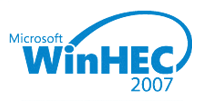WinHEC 2007: What Did We Learn Today?
 LOS ANGELES - Last Monday, we entitled our WinHEC preview, "Time for Vista to Deliver the Goods." The truth ended up being, although goods were indeed delivered, the surprise was that Vista wasn't the delivery vehicle this time around. Windows Server "Longhorn" got a name, but it got more than that: a mission to change the nature of Windows itself, in both the enterprise and the home.
LOS ANGELES - Last Monday, we entitled our WinHEC preview, "Time for Vista to Deliver the Goods." The truth ended up being, although goods were indeed delivered, the surprise was that Vista wasn't the delivery vehicle this time around. Windows Server "Longhorn" got a name, but it got more than that: a mission to change the nature of Windows itself, in both the enterprise and the home.
Without a major new consumer-driven client operating system coming hanging out there in the distance, and with Windows Server 2008 now clearly upon us, this week was the first Microsoft conference in a handful of years not to depend on a truckload of promises of future technologies.
In fact, some reporters (though perhaps fewer attendees, proportionately) actually expressed disappointment that Microsoft didn't expound on the usual promises of four or five years down the road, concentrating this time around on what's available now and what will very likely be available for system developers and hardware engineers no later than the 2008 timeframe.
In this reporter's opinion, it was actually refreshing. For once, Microsoft was concentrating upon pipelines rather than pipe dreams.
Let's revisit the five flashpoints we introduced last Monday, and see how things panned out with respect to those topics we expected would be hot:
5. Flash memory as a PC component. The temperature on this issue was turned down a bit, but not off - from "High" to "Medium." There were some panels on flash memory technologies, but both the delivery and the response appeared to be tepid. During another industry panel on solid state hard drives and hybrid drives, both hard drive and flash memory industry leaders were reluctant to adopt the stance that even hybrid technology would take off significantly, among either consumers or enterprise customers, within the next five years.
Why the reluctance? Although we didn't hear it from them directly, panelists appeared to agree that conventional hard disk drives and memory-enhanced or memory-enabled storage would always constitute separate but valid market segments, perhaps for the next 20 years. If we concede those separate segments will continue to exist for the foreseeable future, there isn't much incentive to predict when - or if - memory-enabled storage will become commonplace.
4. Microsoft, the telephone company. A huge story for WinHEC, as Microsoft unveiled working phones from Polycom and LG-Nortel based on Microsoft reference designs. The prediction we heard from Chris Cullin, who manages Unified Communications for Microsoft - and who we'll hear more from later in BetaNews - is that USB-connective telephony could save businesses as much as 50% over PBX purchases, by the time UC comes into full fruition in 2010.
The message to enterprises: Give up reliance on PBX and save half. It's an extremely compelling argument. However, it relies on Windows' ability to manage voice traffic through the Internet for thousands of major customers - a stress test the likes of which Windows may have never seen before.
3. Making input meaningful again. From our vantage point, this topic appeared to fizzle somewhat, especially after Craig Mundie's demonstration of a pill-pushing checkerboard as part of the all-important opening keynote set.
Perhaps equally the saddest and most parodied moment of the entire conference came during Mundie's demonstration of Microsoft's efforts to create a user interface for cell phones for sale to emerging markets, many of whose citizens, he reminded us, are illiterate. What better cure for illiteracy than Microsoft? After having already warmed up the audience with the drug table from the Twilight Zone, Mundie showed a cell phone interface designed to use pictograms only, guiding users by voice.
Here, a healthcare emergency application for illiterate users calling 911 featured a lady explaining in Hindi the meaning behind the pictogram-based menu shown here, where the user is expected to choose the pictogram that best explains his illness. Number 2, we believe, meant, "Doctor, I seem to have duct tape wrapped around my head." Number 8, meanwhile, maybe means, "Doctor, I've just read an entire Microsoft marketing brochure on PlaysForSure;" while Number 9 may take the crown. "Doctor...I've disappeared!"
For the next two days, attendees were still coming up with, shall we say, unique usage scenarios for the Hindi healthcare app.
Part of the problem here may be a disconnect between Microsoft and the hardware community. In the applications field, Microsoft is often viewed as the company expected to implement the big changes - or at least try. Such was the case with Office 2007, whose introduction of the Ribbon UI model and Office Open XML document formats are having more of an impact on software development than many expected - and more than some wanted.
But in the hardware field, Microsoft isn't exactly the MIT Media Lab (see: "Zune"). The hardware vendors here at WinHEC this week include the companies that may actually manufacture some of the next generation of input devices. What they need from Microsoft isn't an education. They just need some guidance in crafting device drivers, especially in the 64-bit department.
Next: It's a 64-bit world a-comin'...